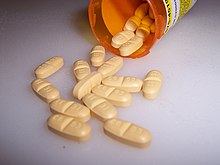Oxcarbazepine
 | |
| Clinical data | |
|---|---|
| Routes of administration | Oral (Tablets or Suspension) |
| ATC code | |
| Legal status | |
| Legal status | |
| Pharmacokinetic data | |
| Bioavailability | > 95% |
| Protein binding | ? |
| Metabolism | Hepatic (Cytosolic Enzymes & Glucuronic Acid) |
| Elimination half-life | 1-5 hours (healthy adults) |
| Excretion | Renal |
| Identifiers | |
| |
| CAS Number | |
| PubChem CID | |
| DrugBank | |
| ChemSpider | |
| CompTox Dashboard (EPA) | |
| ECHA InfoCard | 100.044.702 |
| Chemical and physical data | |
| Formula | C15H12N2O2 |
| Molar mass | 252.268 g/mol g·mol−1 |
| 3D model (JSmol) | |
| |
Oxcarbazepine is an anticonvulsant and mood stabilizing drug, used primarily in the treatment of epilepsy and bipolar disorder. It is also used to treat anxiety disorders and benign motor ticks. Oxcarbazepine is marketed as Trileptal by Novartis and in egypt is marketed also as Oxaleptal 600mg by Mash Premiere and available in some countries as a generic drug.
Oxcarbazepine is a structural derivative of carbamazepine, with a ketone in place of the carbon-carbon double bond on the dibenzazepine ring. This difference helps reduce the impact on the liver of metabolizing the drug, and also prevents the serious forms of anemia or agranulocytosis occasionally associated with carbamazepine. Aside from this reduction in side effects, it is thought to have the same mechanism as carbamazepine - sodium channel inhibition (presumed to be the main mechanism of action) - and is generally used to treat the same conditions. Oxcarbazepine has recently been found to be associated with a greater enhancement in mood and reduction in anxiety symptoms than other drugs employed to treat epilepsy.[1]
History
First synthesized in 1966,[citation needed] it was approved for use as an anticonvulsant in Denmark in 1990. It was approved in Spain in 1993, in Portugal in 1997, and eventually for all other EU countries in 1999. It was approved in the US in 2000.

Pharmacology
Oxcarbazepine is a prodrug which is activated to eslicarbazepine in the liver.[2]
Side effects
Oxcarbazepine causes dizziness, drowsiness, blurred or double vision, fatigue and may cause headaches, nausea, and vomiting. It can also cause hyponatremia (2.7% of patients), so blood sodium levels should be tested if the patient complains of severe fatigue. Some of these side effects (such as headache) are more pronounced shortly after a dose is taken and tend to fade with the passage of time (generally 60 to 90 minutes). A craving for salty foods (such as potato chips) and increased impulsiveness have also been noted. Other side effects include stomach pain; tremor; rash; diarrhea, constipation, decreased appetite; and dry mouth. Skin sensitivity to sunlight also may increase, and patients could experience severe sunburns as a result of sun exposure. The frequency of adverse effects rises above a daily dosage of 1200 mg.
Possible reproductive risks
Oxcarbazapine may cause oral hormonal contraceptives to be less effective.
Increased incidences of fetal structural abnormalities and other manifestations of developmental toxicity (embryolethality, growth retardation) were observed in the offspring of animals (rats and rabbits) treated with either oxcarbazepine or its active 10-hydroxy metabolite (MHD) during pregnancy at doses similar to the maximum recommended human dose.
There are no adequate and well-controlled clinical studies of oxcarbazepine in pregnant women; however, oxcarbazepine is closely related structurally to carbamazepine, which is considered to be teratogenic in humans. Given this fact, and the results of the animal studies described, it is likely that oxcarbazepine is a human teratogen. Oxcarbazepine should be used during pregnancy only if the potential benefit justifies the potential risk to the fetus.
Nursing mothers
Oxcarbazepine and its active metabolite MHD are excreted in human breast milk. Because of the potential for serious adverse reactions to oxcarbazepine in nursing infants, a decision should be made about whether to discontinue nursing or to discontinue the drug in nursing women, taking into account the importance of the drug to the mother.
References
- ^ Mazza M, Della Marca G, Di Nicola M; et al. (2007). "Oxcarbazepine improves mood in patients with epilepsy". Epilepsy Behav. 10 (3): 397–401. doi:10.1016/j.yebeh.2007.01.003. PMID 17300991.
{{cite journal}}: Explicit use of et al. in:|author=(help); Unknown parameter|month=ignored (help)CS1 maint: multiple names: authors list (link) - ^ Dulsat, C., Mealy, N., Castaner, R., Bolos, J. (2009). "Eslicarbazepine acetate". Drugs of the Future. 34 (3): 189.
{{cite journal}}: CS1 maint: multiple names: authors list (link)
- ChemicalLand21.com: Oxcarbazepine
- Trileptal Story
- Trileptal.com(Novartis)
- Prescribing Information(PDF)
